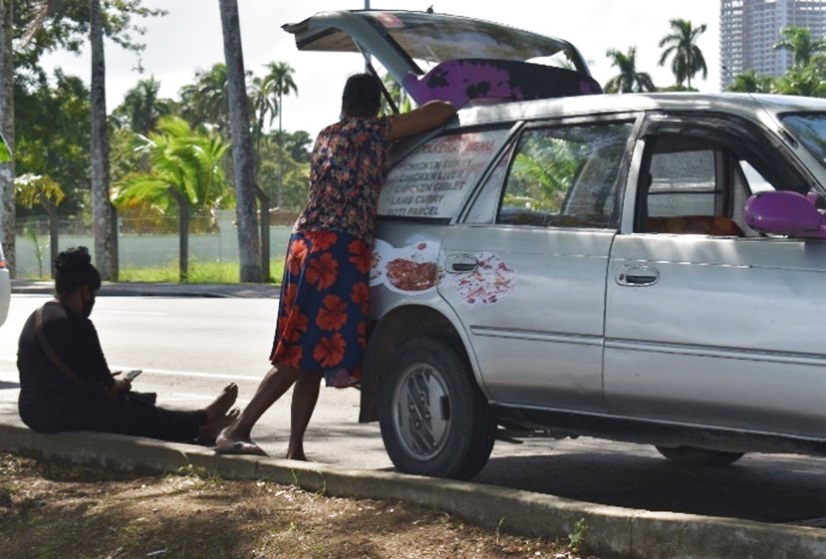In the period between May and August 2021, the Accelerator Lab conducted ethnography and community immersions around the Nasese foreshore and seawall area in Suva, Fiji, exploring how grassroot communities were grappling with the second surge of the COVID-19 pandemic and some of the ways they were navigating their livelihoods. Despite ongoing restrictions and COVID-19 protocols in place, we observed there was no stopping many of the country folks, the ‘new middles’, from instituting their own measures for food and income security. We discovered three strategies that people have adopted during this difficult time.
Re-discovering the sea
In the Pacific, we know that fish and other sea sourced products play an important role in food security and income generation. In-fact relying on the sea has become more pronounced in the last few months, a means to recover from the hardship and disruption caused by the pandemic. We caught up with some women who meet at the Nasese seawall early Saturday mornings to catch the first tide so that they can start gleaning (gathering marine species by hand along the seashore), as well as siwa (line catching) for the incoming fish with the tide. A majority of these women or their partners have lost their jobs due to the pandemic and as a result have now resorted to fishing for sustenance purposes.
Women fishing along the Nasese seawall (Photo: UNDP/Mohseen Dean)
Roadside selling of food
Selling homemade meals along the Nasese seawall (Photo: UNDP/Mohseen Dean)
Following a brief catch up with the ladies, we walked across to vendors selling food along the Nasese seawalls from their cars, modified trucks, buses, and others. We found that the pandemic has left many of these roadside vendors and their families devastated and stretched to the limit.
A Food Box: An innovative method of selling food (Photo: UNDP/Mohseen Dean)
The roadside vendor concept we discovered provide customers the convenience of having their favorite food right outside their offices or neighborhood. Additionally, as a business, they are subject to lower overhead costs than traditional restaurants and have the option of changing locations if business starts declining at their current spot.
Most of the food sold are prepared meals, and some trucks or bus have been re-purposed and inside modified to include a small kitchen. In the food trucks and bus, we find some of the chefs who have lost their jobs at well renowned hotels and restaurants around the country. They have been recruited to cook and sell meals out of the now re-purposed mobile food trucks and buses.
A re-purposed truck, now selling food (Photo: UNDP/Mohseen Dean)
Roadside Vegetable, Fruits and Crop Kiosks
The COVID-19 pandemic has raised enormous volumes of concern for both sellers and consumers in trying to provide a safe marketing option. Across the country, many citizens have taken up agriculture for subsistence and income generation, resulting in an increased number of smaller roadside vegetable, fruits, and crop selling kiosks that have increased overtime.
Currently, the hotspot is the Suva-Nausori corridor and many other feeder roads in the central region with such kiosks occurring at intervals of every one-minute drive along that stretch. Many individuals have also resorted to selling produce from their residential driveway or gates.
The adjoining roads leading to the seawalls in Suva are no different, one will find a kiosk readily available selling fresh produce along roadsides leading to the city. Apart from the supply of fresh produce and supporting the livelihoods of many kiosk owners, these smaller kiosks as a system, are supporting efforts to prevent transmission of COVID-19 virus.
A young entrepreneur sells watermelon by the roadside, near the Nasese seawall. (Photo: UNDP/Mohseen Dean)
Who is the ‘New Middle’?
It is beyond reasonable doubt that the unprecedented COVID-19 pandemic has already affected much of the progress towards equality. To our surprise sadly, the fisherfolks we met, the roadside food selling vendors we visited, and the roadside kiosks we stopped at, we found women and children at the forefront of sourcing livelihoods for their households.
During the first surge of the pandemic, women started to access their secret wallets to overcome the challenges posed by the pandemic, and children had taken up the streets to sell home-made products. By the time the second surge hit, women had emptied their secret wallets to support their households and children selling their products around busy areas in the capital city had risen.
Now more than ever, these women and their children are rising to respond to the exacerbated impacts of the pandemic. As the world charts a course for a post-pandemic future, the question is how can we support the new middle to rise, and how do we rise together? Every actor in the system needs to draw on their strengths collectively – we need to re-think, re-set, re-strategize, and build a better world for future generations so we don’t leave anyone behind.
---
Acknowledgement:
Marissa Asen, Jamil Suleman, and Emily Moli of the UNDP Pacific Office.

 Locations
Locations







